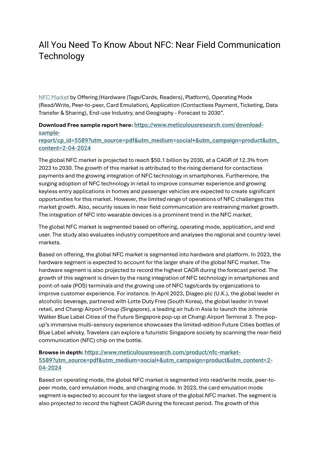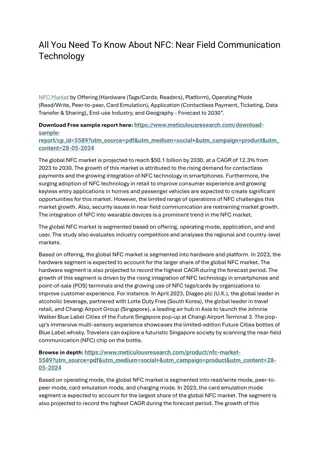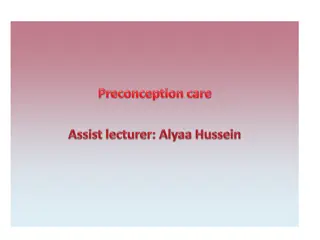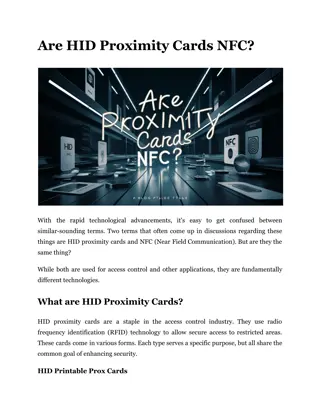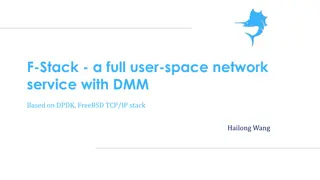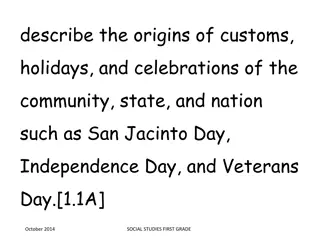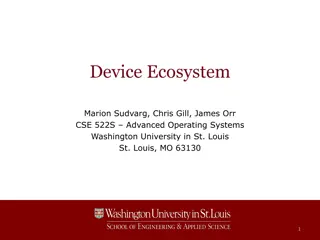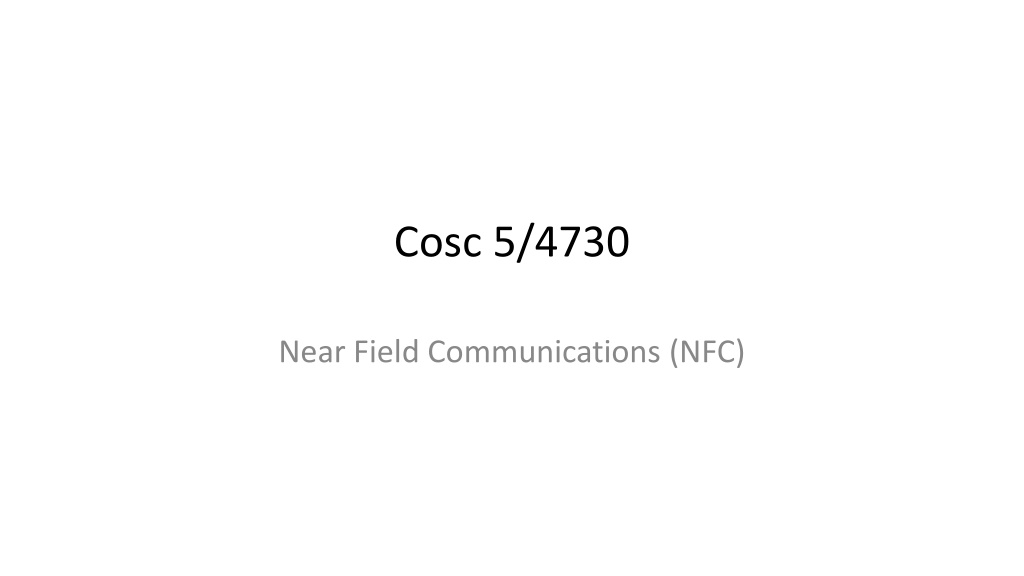
Unlocking the Potential of Near Field Communications (NFC)
Discover the world of Near Field Communications (NFC) and how it enables smartphones to communicate by proximity. Explore the applications, standards, and practical uses of NFC in various scenarios such as contactless transactions, data exchange, and device setups. Learn how NFC technology works and its benefits in simplifying everyday tasks with electronic devices.
Download Presentation

Please find below an Image/Link to download the presentation.
The content on the website is provided AS IS for your information and personal use only. It may not be sold, licensed, or shared on other websites without obtaining consent from the author. If you encounter any issues during the download, it is possible that the publisher has removed the file from their server.
You are allowed to download the files provided on this website for personal or commercial use, subject to the condition that they are used lawfully. All files are the property of their respective owners.
The content on the website is provided AS IS for your information and personal use only. It may not be sold, licensed, or shared on other websites without obtaining consent from the author.
E N D
Presentation Transcript
Cosc 5/4730 Near Field Communications (NFC)
NFC Near field communication (NFC) is a set of standards for smartphones and similar devices to establish radio communication with each other by touching them together or bringing them into close proximity, usually no more than an inch or so. Present and anticipated applications include contactless transactions, data exchange, and simplified setup of more complex communications such as Wi-Fi. Communication is also possible between an NFC device and an unpowered NFC chip, called a "tag".
NFC (2) NFC standards cover communications protocols and data exchange formats, and are based on existing radio-frequency identification (RFID) standards including ISO/IEC 14443 and FeliCa. The standards include ISO/IEC 18092 and those defined by the NFC Forum, which was founded in 2004 by Nokia, Philips and Sony, and now has 150 members. The Forum also promotes NFC and certifies device compliance
About Basically, NFC is a way to enable two electronic devices to establish communication by bringing them within 4 cm of each other You could set up tags all around you for certain tasks On your nightstand, enables your alarm clock and sets device to silent. In your car, launches nav app. In the office, quiets your phone (like you would ever do that).
About (2) Started on Android 2.3, which includes NFC stack and the framework which allows you to read and write to NFC tags. requirement is be running at least Android 2.3 and have an NFC chip.
What do with NFC The number of applications that could use NFC is limited by only by the developers. The first major apps are things like Google wallet, payments systems, and store cards. Otherwise, contact exchange and that sort things. Maybe adding friends in facebook, google+, etc File/Music/Data exchange between devices But remember the devices must be really close. Less then 4cm ( under 2 inches) Tap your phone/tablet on a the wifi access point and it will send the configurations to the device.
What do with NFC (2) Think QR without a camera. Would allow phones to easily respond and react to objects around them. Imagine a world where you can touch a phone to a poster, a piece of furniture, a tag, a keychain, a business card, anything, and expect an application to respond. http://www.tagstand.com/pages/about-nfc http://www.tagstand.com/ is a place you can get stickers with nfc chips in them and customized them to your tag , url, data, etc.
Basics: There are two major uses cases when working with NDEF data and Android: Reading NDEF data from an NFC tag Beaming NDEF messages from one device to another with Android Beam deprecated in android 10. I won't be lecturing on it. Note: None of this will work in the android emulators. You need devices with NFC turned on.
Manifest file. in order to read or write to tag, you need to add an intent-filter to one of you activities with the type of tag you can read/write. Remember you getting information from the nfc sensor which is not part of your app. <activity <intent-filter> <action android:name="android.nfc.action.NDEF_DISCOVERED" /> <category android:name="android.intent.category.DEFAULT" /> <data android:mimeType="text/plain" /> </intent-filter> </activity> make sure the application has the correct permissions in manifest. <uses-permission android:name = "android.permission.NFC /> <uses-feature android:name = "android.hardware.nfc" android:required = true"/>
Check if the sensor is on (if needed) in the onCreate: NfcAdapter nfcAdapter = NfcAdapter.getDefaultAdapter(this); Lets check to make sure we have NFC enabled on this phone. if(nfcAdpater != null && nfcAdpater.isEnabled()) { Toast.makeText(this, "NFC Available!!", Toast. LENGTH LONG).show(); } else { Toast.makeText(this, "NFC not Available :( ", Toast. LENGTH LONG).show(); }
Reading a tag. The intent-filter will direct the "tag" must and it will be received in the activity as a new intent. you must override the onNewIntent(Intent i) { } method. you are guaranteeing at least one piece of information from the tag. You won't get blank data.
Code to read a tag. protected void onNewIntent(Intent intent) { super.onNewIntent(intent); if (NfcAdapter.ACTION_NDEF_DISCOVERED.equals(intent.getAction())) { Parcelable[] rawMessages = intent.getParcelableArrayExtra(NfcAdapter.EXTRA_NDEF_MESSAGES); if (rawMessages != null) { NdefMessage[] messages = new NdefMessage[rawMessages.length]; for (int i = 0; i < rawMessages.length; i++) { messages[i] = (NdefMessage) rawMessages[i]; } // Process the messages array. for (NdefMessage message : messages) { //there always going to be at least one record, so msg[0] will always exist, but could be more. NdefRecord[] msg = message.getRecords(); for (int j = 0; j < msg.length; j++) { String body = new String(msg[j].getPayload()); logthis("record " + j + " is " + body); } } } } }
Writing to a tag This is more difficult in code. 1. You must disable reading of the TAG. you can't read and write at the same time. 2. Enable writing to a TAG You also need to have whatever you want to write to the tag ready as well. This done via pending intent, my demo code sends it to an activity, but broadcast receiver or even service could be used as well. 3. Now the user can touch the TAG 4. Your activity will get intent via onNewIntent (or broadcast receiver/service) 5. now you can "connect" to the tag and write out the message. Note, you also have to deal with your app being paused an resumed.
Turning on/off read mode. removed in API 34 * This will turn off reading of devices/tags. private void disableNdefExchangeMode() { mNfcAdapter.disableForegroundNdefPush(this); //deprecated, but required. mNfcAdapter.setNdefPushMessage(null, MainActivity.this); //turn it off. mNfcAdapter.disableForegroundDispatch(this); } Turns on reading of devices/tags private void enableNdefExchangeMode() { byte[] textBytes = "What?".getBytes(); //honesty don't know why this is needed. NdefRecord textRecord = new NdefRecord(NdefRecord.TNF_MIME_MEDIA, "text/plain".getBytes(), new byte[]{}, textBytes); NdefMessage Ndefmsg = new NdefMessage(new NdefRecord[]{textRecord}); mNfcAdapter.enableForegroundNdefPush(MainActivity.this, Ndefmsg); //deprecated, take this out and it won't work. mNfcAdapter.setNdefPushMessage(Ndefmsg, MainActivity.this); mNfcAdapter.enableForegroundDispatch(this, mNfcPendingIntent, mNdefExchangeFilters, null); } Where the mNfcPendingIntent references this activity. or you can set to a broadcaster receiver or service.
turning on/off write mode. removed in API 34 turns on the wrote mode, so when we receive a tag/device. private void enableTagWriteMode() { logthis("Enabling writing to Tag now"); IntentFilter tagDetected = new IntentFilter(NfcAdapter.ACTION_TAG_DISCOVERED); mWriteTagFilters = new IntentFilter[]{tagDetected}; mNfcAdapter.enableForegroundDispatch(this, mNfcPendingIntent, mWriteTagFilters, null); } Turns off the write mode. We still get new TAGS because of the intent filter. but the write is off. private void disableTagWriteMode() { logthis("Disabling writing to tag"); mNfcAdapter.disableForegroundDispatch(this); }
writing a tag. //note writeTag is not a required function, just makes easier. } else { //NOT formatted, so we going to format and write NdefFormatable format = NdefFormatable.get(tag); if (format != null) { try { format.connect(); format.format(message); logthis("Formatted tag and wrote message"); return true; } catch (IOException e) { logthis("Failed to format tag."); return false; } } else { logthis("Tag doesn't support NDEF."); return false; } } } catch (Exception e) { logthis("Failed to write tag"); } boolean writeTag(NdefMessage message, Tag tag) { int size = message.toByteArray().length; try { Ndef ndef = Ndef.get(tag); if (ndef != null) { ndef.connect(); if (!ndef.isWritable()) { logthis("Tag is read-only."); return false; } if (ndef.getMaxSize() < size) { logthis("Tag capacity is " + ndef.getMaxSize() + " bytes, message is " + size + " bytes."); return false; } ndef.writeNdefMessage(message); logthis("Wrote message to pre-formatted tag."); return true; return false; }
enableReaderMode This method doesn't require any intents and is while the activity is up. AndroidManifest.xml still needs permissions, but nothing else. <uses-permission android:name="android.permission.NFC" /> <uses-feature android:name="android.hardware.nfc" android:required="true" /> It has a listener, that when it senses a tag, it called.
turning on the readerMode Bundle options = new Bundle(); options.putInt(NfcAdapter.EXTRA_READER_PRESENCE_CHECK_DELAY, 250); // Listen for all types of card when this App is in the foreground // Turn platform sounds off as they misdirect users when writing to the card // Turn of the platform decoding any NDEF data mNfcAdapter.enableReaderMode(this, //activity this //callback, NfcAdapter.FLAG_READER_NFC_A | NfcAdapter.FLAG_READER_NFC_B | NfcAdapter.FLAG_READER_NFC_F | NfcAdapter.FLAG_READER_NFC_V | NfcAdapter.FLAG_READER_NFC_BARCODE | NfcAdapter.FLAG_READER_NO_PLATFORM_SOUNDS, options);
callback AppcompatActivity implements NfcAdapter.ReaderCallback we need the callback implemented @Override public void onTagDiscovered(Tag tag) { //Found a tag //now you can read the tag or write the tag }
disabling reader mode if (mNfcAdapter != null) { mNfcAdapter.disableReaderMode(this); //where this is the activity. }
reading the tag. You can use each method ie nfcA, B, etc to read the tag as needed or you can use the Ndef to read the tag. this what the example does void readTag(Tag tag) { logthis("Attempting to read tag"); Ndef mNdef = Ndef.get(tag); if (mNdef != null) { // As we did not turn on the NfcAdapter.FLAG_READER_SKIP_NDEF_CHECK // We can get the cached Ndef message the system read for us. NdefMessage mNdefMessage = mNdef.getCachedNdefMessage(); NdefRecord[] msg = mNdefMessage.getRecords(); for (int j = 0; j < msg.length; j++) { String body = new String(msg[j].getPayload()); logthis("record " + j + " is " + body); } } else { logthis("mNdf is null"); } }
Examples NFCreadDemo Uses intents. just reads tags. it's pretty simple code and displays what it reads. NFCReadWriteDemo Uses readerMode Will read tags. If you set the writer, it will also write tags.
Tags References Using intents: http://developer.android.com/reference/android/nfc/NfcAdapter.html#getDefaultAdapter%28android.conten t.Context%29 https://www.youtube.com/watch?v=aiSHHj7jWpQ&index=3&list=PLJebtGlguLPP8IRW9Vzrt2D9Ay4IXmy64 http://developer.android.com/guide/topics/connectivity/nfc/index.html http://code.tutsplus.com/tutorials/reading-nfc-tags-with-android--mobile-17278 http://mifareclassicdetectiononandroid.blogspot.com/2011/04/reading-mifare-classic-1k-from-android.html enable reader mode https://stackoverflow.com/questions/64920307/how-to-write-ndef-records-to-nfc-tag/64921434#64921434 (assuming it hasn't changed, this the best answer here). https://stackoverflow.com/questions/40288795/android-nfca-connect-nfca-transceive-nfca-settimeout-and- nfca-getmaxtran https://stackoverflow.com/questions/71657452/android-nfcadapter-enablereadermode-callback-not-called https://github.com/SMARTRACTECHNOLOGY-PUBLIC/smartrac-sdk-java-android-nfc/blob/master/nfc- ntag/How-to%20Read%20data%20from%20NFC%20NTAG.md https://stackoverflow.com/questions/59395861/write-nfc-data-on-an-tag-with-android- studio/59397667#59397667
Last Note Google/Samsung/others are working on a compatible or better then Apple AirDrop Android Beam didn't work out as expected. Honestly, it was terrible and slow. Basically it need to use Bluetooth, wifi, and nfc to work, plus backward compatible to at least Android 8? And apple has not interest in supporting it or work on an android version.
nearby share https://www.androidcentral.com/how-use-nearby-share-your- android-phone It was supposed to replace beam but has not been as successful as hoped. We will look at nearby protocols later on.
References http://en.wikipedia.org/wiki/Near_field_communication Android http://developer.android.com/guide/topics/connectivity/nfc/index.html http://developer.android.com/resources/samples/NFCDemo/index.html http://stackoverflow.com/questions/5078649/android-nfc-sample-demo-reads-only-fake-information-from-the-tag http://www.jessechen.net/blog/how-to-nfc-on-the-android-platform/ https://github.com/commonsguy/cw- omnibus/blob/master/NFC/FileBeam/src/com/commonsware/android/filebeam/MainActivity.java http://stackoverflow.com/questions/8648149/bi-directional-android-beam?rq=1 http://developer.android.com/reference/android/nfc/NfcAdapter.html#setNdefPushMessage%28android.nfc.NdefMessage,%20a ndroid.app.Activity,%20android.app.Activity...%29 http://developer.android.com/guide/topics/connectivity/nfc/nfc.html http://stackoverflow.com/questions/10265928/writing-data-into-nfc-tag-in-android-tutorial http://code.google.com/p/ndef-tools-for-android/downloads/list http://www.jessechen.net/blog/how-to-nfc-on-the-android-platform/ with a video explanation as well. http://stackoverflow.com/questions/5762234/nfc-tutorial-for-android-other-than-api-demo
QA &


